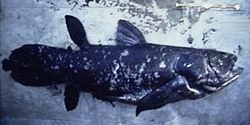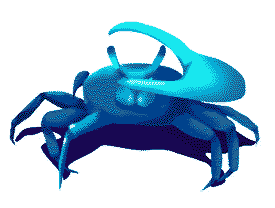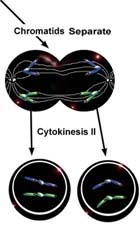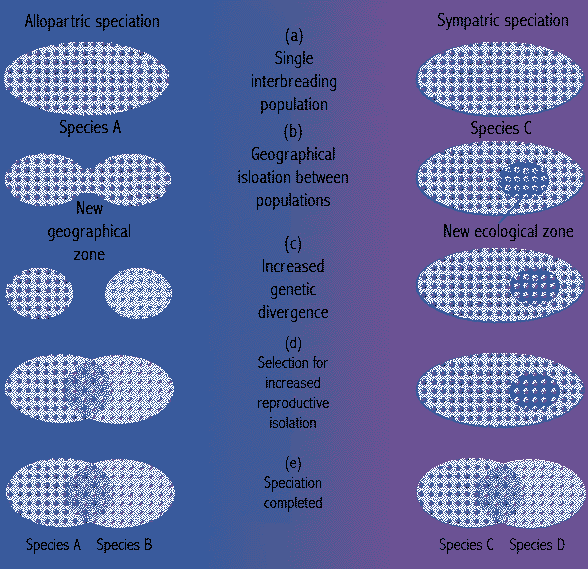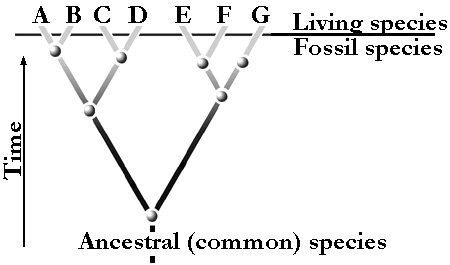In this lesson, we wish to ask:
Evolution and Its Many FormsToday we continue a three-lecture sequence on biological, or organic, evolution. Evolution is a unifying theme of this course, and the concept of evolution is relevant to many of our topics.The word "evolution" does not apply exclusively to biological evolution. The universe and our solar system have developed out of the explosion of matter that began our known universe. Chemical elements have evolved from simpler matter. Life has evolved from non-life, and complex organisms from simpler forms. Languages, religions, and political systems all evolve. Hence, evolution is an appropriate theme for a course on global change. The core aspects of evolution are "change" and the role of history, in that past events have an influence over what changes occur subsequently. In biological evolution this might mean that complex organisms arise out of simpler ancestors - though be aware that this is an over-simplification not acceptable to a more advanced discussion of evolution. A full discussion of evolution requires a detailed explanation of genetics, because science has given us a good understanding of the genetic basis of evolution. It also requires an investigation of the differences that characterize species, genera, indeed the entire tree of life, because these are the phenomena that the theory of evolution seeks to explain. We will begin with observed patterns
of similarities and differences among species, because this is what Darwin
knew about. The genetic basis for evolution only began to be integrated
into evolutionary theory in the 1930's and 1940's. We will add genetics
into our understanding of evolution through a discussion activity.
Definitions of Biological EvolutionWe begin with two working definitions of biological evolution, which capture these two facets of genetics and differences among life forms. Then we will ask what is a species, and how does a species arise?
Changes in the genetic composition of a population with the passage of each generation The gradual change of living things from one form into another over the course of time, the origin of species and lineages by descent of living forms from ancestral forms, and the generation of diversity A full explanation of evolution requires that we link these two levels. Can small, gradual change produce distinct species? How does it occur, and how do we decide when species are species? Hopefully you will see the connections by the end of these three lectures. Today we will discuss how species
are formed. But to do this, we need to define what we are talking about.
What is a Species?Despite our increasing ability to understand the finest details of organisms, there is still debate about what constitutes a species. Definitions of species tend to fall into two main camps, the morphological and the biological species concepts.
Mimicry complexes supplied further evidence against the concept, as organisms of the same species can look very different, depending upon where they are reared or their life cycle stage (some insects produce a spring brood that looks like one host plant and a summer brood that looks like another). The morphological species concept was replaced by another viewpoint that puts more emphasis on the biological differences between species.
This concept also emphasized that a species is an evolutionary unit. Members share genes with other members of their species, and not with members of other species. Although this definition clearly is attractive, it has problems. Can you test it on museum specimens or fossil data? Can it explain the existence of species in a line of descent, such as the well-known lineage of fossil horses? Obviously not. In fact, one cannot apply this definition easily, or at all, with many living organisms. What if species do not live in the same place? What about the hybrids that we know occur in zoos? These problems are serious enough that some biologists recently argued for a return to the morphological species concept. So what is the best way to define a species? Most scientists feel that the biological species concept should be kept, but with some qualifications. It can only be used with living species, and cannot always be applied to species that do not live in the same place. The real test applies to species that have the potential to interbreed. Most importantly, the biological
species concept helps us ask how species are formed, because it focuses
our attention on the question of how reproductive isolation comes about.
Let us first examine types of reproductive isolation, because there are
quite a few.
Types of Reproductive IsolationThere are many barriers to reproduction. Each species may have its own courtship displays, or breeding season, so that members of the two species do not have the opportunity to interbreed. Or, the two species may be unable to interbreed successfully because of failure of the egg to become fertilized or to develop.This suggests a simple and useful dichotomy, between pre-mating or prezygotic (i.e., pre-zygote formation) reproductive isolating mechanisms, and post-mating or postzygotic isolating mechanisms. Remember that a zygote is the cell formed by the union of two gametes and is the basis of a developing individual. Prezygotic isolating mechanisms
Species FormationHow do we get cladogenesis -- the splitting of one lineage into two?This question is critical, because it is what produces many species from few, and results in evolutionary trees of relatedness. The most common way for species to split, especially in animal species (we will talk more about the origin of new plant species later), is when the population becomes geographically isolated into two populations. This is referred to as allopatric (geographic) speciation (see Figure).
Geographic isolation leads to reproductive isolation. Once two populations are reproductively isolated, they are free to follow different evolutionary paths. They are likely to differentiate for two reasons:
Differentiation also depends upon the strength of selective pressures. Strong selection can cause rapid change. Given time and selection, the two populations become two species. They may, at some later time, spread back into contact. Then we can ask, are these two "good biological species"? The real test of the biological species concept is when two populations, on the threshold of becoming two species, come back into contact. They may simply merge. They may be so different that they do not even recognize one another as species. Often, though, species may come into contact when not yet fully reproductively isolated. In that event, natural selection should reinforce the reproductive barriers. Why? Because individuals that waste their reproductive effort -- their gametes -- on individuals with whom they will produce inferior offspring are less likely to pass on their genes to the next generation. Natural selection should reinforce reproductive isolation. Probably, species that are isolated only by post-zygotic barriers will subsequently evolve pre-zygotic barriers. Why should that occur? To review: allopatric (geographic)
speciation is the differentiation of physically isolated populations
to the point that reunion of the two populations does not occur if contact
is re- established.
Speciation as a Gradual ProcessOur understanding of speciation arising from reproductive isolation and the gradual evolution of reproductive isolating mechanisms should help us to appreciate why the biological species concept, and the test of reproductive isolation, may sometimes fail.If speciation is a gradual process, species may not yet be fully separated. A continuum must exist from species that are in the process of splitting into two, to species that are fully formed. Surely we only expect the latter to behave as "good species." We still haven't fully explained the speciation process. In our next lesson, we will examine the theory of natural selection, which helps to explain how localized populations become adapted to local conditions. By adapting to local conditions and accumulating genetic differences, isolated geographic races start down the path to becoming separate species and creating another pair of branches on the tree of life. But now I want to point out that there are alternative models of species formation, and finally I want to conclude by linking the concept of species formation to the hierarchical structure of life. Alternative Models of Species Formation -- Hybridization and PolyploidyIn plants, new, reproductively isolated species may arise instantaneously, due to multiplication of the entire complement of chromosomes by a process known as polyploidy. This may occur as a result of hybridization, combining the chromosome sets from two parent species in a hybrid individual. If such hybrids turn out to be well adapted to environmental conditions, hybridization is a mechanism that produces new species.Even if hybrids are unable to undergo sexual reproduction because their chromosomes do not sort out properly in meiosis, they may reproduce vegetatively. The total chromosome number also may double by combining the chromosome sets of a single species. Of the 260,000 known species of plants,
as many as half may have originated in this way. Many commercially important
plants are examples of polyploidy (e.g. bread wheat, cotton, tobacco, sugar
cane, bananas, potatoes). Polyploidy is an example of sympatric speciation
defined as species arising within the same, overlapping geographic range.
Conclusion: Species Formation and the Hierarchy of LifeSpeciation results in the splitting of an ancestral species into two (or more) descendent species. This process, continued indefinitely, results in a sequence of speciation events extending over great expanses of time, resulting in a branching tree of historical relatedness. Imagine if we had complete and certain knowledge of such a tree -- it would tell us the evolutionary relatedness among living things, the pathways of divergence, even the timing of separation.There are two ways to construct a phylogenetic tree (see Figure). We can use a "perfect" fossil record to trace the sequence from beginning to end, or we can use similarities and differences among living things to reconstruct history, working from the endpoint toward the beginning.
In this course, we will not consider these two methods in detail. I introduce them to make the point that, ultimately, we want to understand how evolution produces not just two species from one but the entire tree of life. This requires that we make the transition from microevolution to macroevolution. To Darwin, and to modern evolutionary biologists as well, the answer simply is time. Given enough time and successive splittings, the processes that produce two species from one will result in the entire diversity of life. In reality, deducing the historic record of branching is very difficult. Data are incomplete, scientists debate the pace of change, and sometimes species separated by many branching steps look more similar to one another than those separated by one or a few branches. Molecular biology offers exciting new opportunities to address these issues, by looking at similarities and differences in DNA sequences. From here we will turn away from the macroevolutionary view and look more closely at how small changes occur and accumulate, by the processes of natural selection and genetic change. SummaryBiological evolution can be defined in two ways: as a result of changes in the genetic composition of a population with the passage of each generation (microevolution), or as a result of the gradual change of living things from one form into another over the course of time, generating species diversity (macroevolution).The definition of a species is debatable. Most scientists adhere either to the morphological species concept (members of a species look alike and can be distinguished from other species by their appearance), or to the biological species concept (a species is a group of actually or potentially interbreeding individuals who are reproductively isolated from other such groups). Both definitions have their weaknesses. Reproductive isolating mechanisms are either prezygotic or postzygotic. These mechanisms ensure that species remain distinct in nature. Species formation can occur either through allopatric (geographic) speciation or through sympatric speciation. We can construct phylogenetic trees that show the evolutionary relatedness among living things, though the building of such trees is as yet an imperfect science. Suggested Readings:
Copyright Regents of the University of Michigan unless noted otherwise. |
